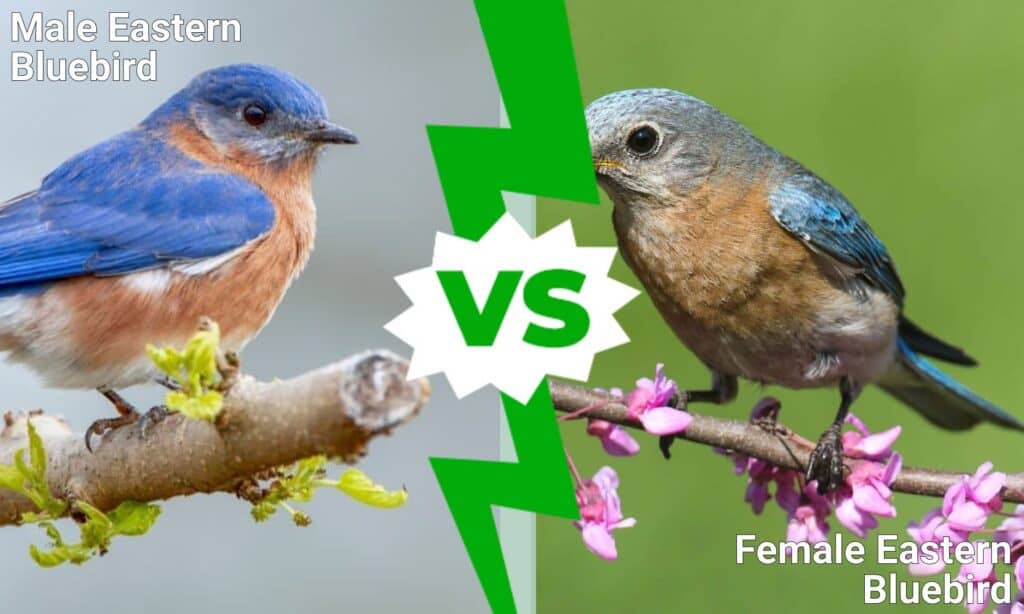Bluebirds are some of the most beautiful backyard birds in North America, but how can you tell them apart? Even if you figure out how to identify different species of bluebirds (like the western or mountain bluebird), it’s still tough to find out if it’s a male or female. Today, we are going to learn all about eastern bluebirds and how to tell males and females apart. Let’s get started.
Comparing an Eastern Bluebird Male vs Female

| Male eastern bluebird | Female eastern bluebird | |
|---|---|---|
| Size | Length: 6-8 inches Weight: 0.9-1.1 oz | Length: 6.3-8.3 inches Weight: 1.02-1.13 oz |
| Coloration | Vividly blue with rusty-orange neck and breast. White belly and underside. | Grayish-blue backs with occasional streaks of vivid blue on wings and tails. Subdued orange neck and breast. White belly and underside. |
| Reproduction | Cooperate in raising young but doesn’t participate in nest building. | Two broods each season. Pale-blue eggs. Nest primarily constructed by the female. |
The 3 main differences between a Male and Female Eastern Bluebird
Male eastern bluebirds are slightly smaller, have a brighter blue plumage, and participate in the feeding of bluebird chicks. Female eastern bluebirds are slightly larger, have dull gray plumage, and take primary care of bluebird chicks.
Eastern bluebirds are one of three bluebird species, with the others being the western and mountain bluebirds. As their name suggests, eastern bluebirds live in the eastern United States, with a western range that extends as far as Texas. These birds are known for their beautiful blue plumage (especially during breeding season) and can be seen near feeders, backyards, and more. There are seven subspecies of eastern bluebird, mostly separated by geography.
Eastern bluebirds are relatively common within their range and are easily distinguished by their blue and orange colorations. Still, it can often be hard to pick out the difference between a male and a female within the species.
Let’s explore these differences in some more detail below.
Eastern Bluebird Male vs Female: Size

Bluebirds aren’t different enough in size to be noticeable to the eye.
©Steve Byland/Shutterstock.com
Male and female bluebirds are extremely similar in size, although if there is a difference, it would slightly favor females. They generally measure 6.3-8.3 in and weigh 0.9-1.1 oz.
Female bluebirds are generally the same size as males, but some instances show them to a slightly larger in some scenarios. They can measure 6-8 inches and weigh 1.02-1.13 oz.
Eastern Bluebird Male vs Female: Coloration

Male bluebirds are more vibrant and blue than the mostly blue-gray females.
©iStock.com/MelodyanneM
One of the biggest visual differences between male and female bluebirds is their color. Males have a vibrant blue color across their backs and heads, especially during mating season when their colors really pop. Their necks and breasts are a rusty-orange color and their bellies are white or cream.
Females are less vibrant than their male counterparts in most regards. Their backs are a dull blue-gray, although vibrant flecks of blue could be present. Their necks and breasts are a lighter shade of rusty orange, and their bellies are white or cream.
Eastern Bluebird Male vs Female: Reproduction

Male eastern bluebird helps to feed their young ones.
©Steve Byland/Shutterstock.com
Although the difference isn’t visual, male and female bluebirds play different roles in reproduction. Male bluebirds don’t participate in nest building or brooding. Outside of the act of reproducing itself, they will help the female feed the young and watch out for predators.
Female bluebirds are responsible for building nests, laying and incubating the eggs, and brooding over the chicks. A few days after hatching, females will help find food for the young.
The photo featured at the top of this post is © Steve Byland/Shutterstock.com
Thank you for reading! Have some feedback for us? Contact the AZ Animals editorial team.






